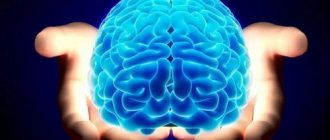Classification by E.A. Zhirmunskaya
A system for describing EEG types (patterns) and groups was proposed by E.A. Zhirmunskaya in 1984 and is still the basis for visual, verbal assessment of EEG. It should be noted that according to the classification of E.A. Zhirmunskaya's (1991) concept of EEG type refers only to resting EEG recorded in subjects in a state of passive wakefulness, with their eyes closed, and does not include changes that occur in response to efferent stimuli.
The advantage of this classification is the ability to give a general description of the EEG. This creates a certain convenience for the subsequent formation of a conclusion by a medical specialist. At the same time, when making a judgment about the type of EEG, the nature of the EEG pattern in various types of epilepsy is not taken into account, and the focus of pathological activity is not highlighted. According to the classification of E.A. Zhirmunskaya distinguishes 5 types of EEG.
Type I – organized (normal EEG)
The main component of the EEG is the α rhythm, regular in frequency, clearly modulated into spindles, with a medium and high index, with well-defined zonal differences. The α rhythm has the highest amplitude (50-70 μV) in the occipital leads. Towards the anterior parts of the cortex, the severity of the α rhythm decreases. The wave shape is usually smooth. In the temporal regions of the cortex, the α rhythm is presented in the form of fragmentary low-amplitude spindles.
Slow waves are almost not pronounced. δ-activity can also be recorded in the form of single diffuse waves of small amplitude (Fig. 1).
It is advisable to classify EEG with a less ordered structural and spatial organization as this type, the main criterion of which is pronounced α-activity (Fig. 2).
EEGs belonging to type I are interpreted as the ideal norm or as slight changes within the acceptable range of the norm.
Rice. 1. Male, 46 years old.
Electroencephalogram within the age norm. The α-rhythm is modulated, zonal differences are clearly expressed, fragmentary θ- and δ-waves are recorded in the anterior sections
Rice. 2. Man, 72 years old.
Electroencephalogram within the age norm. The α-rhythm is weakly modulated, zonal differences are clearly expressed. Diffuse θ- and δ-activity is recorded in the fronto-central regions
Type II – hypersynchronous (monorhythmic)
It may have variants with a predominance in all areas of the brain or only the α-rhythm, low-frequency ß-activity, or rhythmic θ-activity. The main thing in the structure of this type is the high index of regular fluctuations of biopotentials with the loss of their zonal differences.
Various options for such enhancement of activity synchronization are possible: with preservation and even enhancement of α-range oscillations; with the disappearance of α-activity and its replacement by low-frequency ß-activity or θ-activity. The main characteristic of this type of EEG is the increased regularity of oscillations in the α- (less often ß- or θ-) ranges with the absence of zonal differences.
The option when the α-rhythm dominates, unmodulated or weakly modulated with mild or distorted zonal differences and the absence of fast and slow activity, refers to a moderately disturbed EEG (Fig. 3, 4).
When regular ß-activity with a frequency of 14-25 Hz of small amplitude predominates, the EEG is also considered moderately impaired. In the presence of moderately high or high ß-activity, the EEG is characterized as significantly impaired (Fig. 5).
Rice. 3. Woman, 60 years old.
Encephalopathy. The electroencephalogram shows a hypersynchronous weakly modulated α-rhythm, enhanced in all leads, zonal differences are reduced
Rice. 4. Man, 50 years old.
Symptomatic partial epilepsy. The electroencephalogram shows a hypersynchronous weakly modulated α-rhythm, enhanced in the frontal-central-parietal regions of the brain, zonal differences are reduced, synchronous bilateral discharges of α- and δ-wave complexes periodically occur
Rice. 5. Male, 45 years old.
A complex of functional disorders in the intestines, a feeling of discomfort, increased emotionality. The electroencephalogram shows hypersynchronous high-amplitude ß-activity, enhanced in all leads
Type III – desynchronous (normal variant)
EEG is characterized by low-amplitude bioelectrical activity with the absence or sharp decrease in the number of α-waves. ß-Activity is moderate, diffuse θ- and δ-waves of small amplitude are noted (Fig. 6).
EEGs classified as types II and III reflect regulatory changes in brain activity. In type II, there is a weakening of the activating influences on the cortex from the reticular formation of the brain stem and an increase in deactivating influences from other parts of the limbic-reticular complex.
In type III, on the contrary, there is an increase in activating influences from the reticular formation of the brain stem, which is expressed in desynchronization of α-activity on the EEG. EEGs classified as types II and III reflect regulatory changes in brain activity. Types II and III EEG can occur in patients with neuroses, vegetative-vascular dystonia, cervical osteochondrosis and a number of other diseases.
Rice. 6. Male, 19 years old.
There are no neurological complaints. The electroencephalogram shows low-amplitude bioelectrical activity with the presence of irregular diffuse Θ- and δ-waves. α-Activity is fragmentary and low-amplitude. Variant of the norm
Type IV – disorganized (with a predominance of α-activity)
On the EEG, the main activity is α-activity. In this case, there is significant disorganization of the α-rhythm in all parameters: frequency, amplitude, waveform, distortion of zonal differences. This disorganized α rhythm can dominate all areas of the brain. ß-Activity is also often enhanced, often represented by low-frequency oscillations and increased amplitude; there is an increase in the index of θ- and δ-waves with a fairly high amplitude, the appearance of peaks, sharp waves, flashes and complexes in different areas of the brain. This type of EEG reflects changes in biopotentials in many diseases, which can be associated with microstructural lesions in different parts of the brain, including the cerebral cortex. This category includes atherosclerosis, transient ischemic attacks, neuroinfections, and closed craniocerebral injuries (Fig. 7; 8; 9). Disturbances of the walls of brain vessels and microscopic lesions of brain tissue that occur in these diseases are accompanied by changes in metabolism and neurodynamic disorders. This is accompanied by dysfunction in the activity of the regulatory systems of the brain.
Rice. 7. Male, 38 years old.
5 years ago there was a severe traumatic brain injury with loss of consciousness, loss of ability to work: impaired coordination of movement, slowness of speech. The electroencephalogram was recorded against the background of restoration of working capacity, disorganization of the α-rhythm in shape and frequency, the presence of θ-, δ-rhythm and sharp waves were noted
Rice. 8. Male, 31 years old.
Rice. 9. Woman, 22 years old.
Prolactinemia. The electroencephalogram shows disorganization of the α-rhythm, the presence of sharp waves, and groups of θ-activity
Type V – disorganized (with a predominance of θ- and δ-activity)
δ-Activity is poorly expressed. Amplitude level is medium or high. The type is characterized by the weak presence of α-activity. Fluctuations in biopotentials in the α-, ß-, θ- and δ-ranges are recorded without a clear sequence (Fig. 10).
Type V means that in patients it is no longer regulatory, but microstructural lesions in the cerebral cortex that come to the fore. If there is an EEG of this type, there is every reason to talk about organic brain damage. If an EEG of this type shows a clear focus of pathological activity or a distinct interhemispheric asymmetry, we can assume the presence of a gross macrofocal lesion in one of the brain hemispheres (Fig. 11). In the presence of local pathological activity, it is recommended to view the EEG in bipolar montage mode, which will clarify the localization of the lesion (Fig. 12, 13). The appearance of both local and diffuse pathological phenomena and paroxysmal discharges most often accompanies this particular type of EEG, although it can also occur against the background of any other type of EEG.
Rice. 10. Woman, 66 years old. Secondary generalized convulsive attack.
Cyst in the right anterior frontal region. On the electroencephalogram, fluctuations in the biopotentials of the α-, ß-, Θ- and δ-ranges are recorded without any clear sequence. A clear focus of δ activity is detected in the right temporal region
Rice. 11. Male, 24 years old.
At the age of 8 years he was operated on for a tumor in the left frontotemporal region. At the age of 10, a tumor of the optic chiasm was discovered; bone grafting was not performed. Currently there are generalized seizures at night. The electroencephalogram shows disorganized bioelectrical activity and the presence of local δ-activity in the fronto-parietal-temporal region of the left hemisphere
Rice. 12. Woman, 19 years old.
Partial epilepsy. The electroencephalogram shows disorganized bioelectrical activity, the presence of local δ-activity in the central region of the left hemisphere and the temporal region of the right hemisphere, and a focus of ß-activity in the parietal regions of the right hemisphere
Rice. 13. Woman, 19 years old. Partial epilepsy.
With bipolar montage, the same segment of the electroencephalogram is presented as in Fig. 2.43 δ-activity in leads F3-C3, SZ-RZ and in leads F8-T4 is recorded in antiphase, which suggests the presence of lesions in the left central region (C3) and in the right temporal region (T4) respectively.
How EEG works
The human brain is made up of millions of cells (neurons). Each cell produces its own electrical impulse. These impulses must be consistent within each individual region of the brain. Their amplitude and strength are constantly changing, and they can strengthen or weaken each other. This is the bioelectrical activity of the brain.
Electroencephalography (EEG)
A highly sensitive research method that reflects the slightest changes in the function of the cerebral cortex and deep brain structures in the time dimension.
To record brain activity, special electrodes are placed on the scalp that will pick up vibrations and record them in the form of curves. Each of these waves reflects the functioning of a specific part of the brain. Recording waveforms in real time is the essence of encephalography. Such an examination allows you to track pathological processes and signs of epilepsy.
On average, the procedure lasts about an hour and does not cause discomfort and is considered one of the most accurate and gentle ways to examine the brain.
EEG classification according to Luders
The EEG classification according to Lüders1 is very detailed, it includes both artifacts and rare types of EEG.
- Slow activity Slow down background activity
- Transient slowdown
- Continued deceleration
- Spikes
- Excessive fast activity
- Alpha Coma
- Temporal deceleration in the elderly
EEG classification according to Gibbs
According to Gibbs et al. (1943), a normal EEG is represented by:
- recordings in which alpha waves dominate and there are a small number of fast and slow waves,
- recordings in which low-amplitude, fast oscillations dominate, mixed with low-amplitude activity (below 20 μV) of various frequencies.
Using these criteria, Gibbs et al recorded normal EEG in 85–90% of healthy adults examined. Greenstein et al. (1948) believe that when assessing the “normality” of the EEG, the so-called delta index is also essential. It should not exceed 8 in the frontal lead (relative to the ear electrode) and 5 in other leads. In addition, rapid activity, if it appears symmetrically in both hemispheres and not in separate bursts, even if it is not diffusely distributed throughout the cerebral cortex, should not be considered an abnormality.
Decoding of electroencephalogram indicators
To correctly decipher the EEG, a specialist needs:
- Don’t miss a single detail in the recording
- take into account all important points that may affect the indicators (for example, the patient’s age, the presence of certain diseases, possible contraindications, etc.).
After collecting all the data and processing it, a final conclusion is formed, on which the doctor will rely when choosing a treatment method. Any disturbance in the activity of neurons may be a symptom of diseases caused by certain criteria.
If the decoding is made with errors, then the diagnosis will be made incorrectly and the prescribed treatment will not give a positive result. Therefore, to decipher the results of EEG studies, you should contact a qualified specialist!
A high-quality medical examination will prevent new diseases and keep existing ones under control. Take care of your health! You can undergo an EEG at our MEDKOM medical center.
EEG classification according to Jung
Jung (1953) distinguishes four variants of an unchanged EEG:
- The alpha electroencephalogram contains a well-defined alpha rhythm, the frequency of which fluctuates by no more than 1–1.5 waves per second. Low amplitude beta waves occur in short bursts in the precentral region. Theta waves are barely visible.
- The beta electroencephalogram is dominated by waves with a frequency of 16 to 25 per second with an amplitude of 20–30 μV, recorded partly continuously in the recording, partly in the form of separate groups or series.
- A flat EEG contains a very rare low-amplitude alpha rhythm, a beta rhythm that is small and difficult to distinguish, and flat theta waves are also found. Similar EEGs occur in more than 10% of healthy people. Flat EEGs with an accelerated main type of activity can be detected during mental stress. Transient flattening of the EEG is also detected when alpha waves are blocked during the stage of falling asleep (referred to by some authors as stage zero, for example, Roth, 1962).
- An irregular EEG contains an alpha rhythm, the average frequency of which fluctuates ± 1.5 waves per second. The maximum amplitude of the alpha rhythm in the occipital leads is not clearly expressed. Theta waves, superimposed on alpha waves, are more pronounced in the anterior and temporal regions than in the parietal regions, where they are sometimes visible as components of the lower harmonics of the alpha rhythm.
Such irregular EEGs occur in healthy people as often as flat EEGs. They are more common in youth and in older age and present difficulties in distinguishing them from EEGs with pronounced frequency instability, which represent a transition to dysrhythmia. Transient EEG irregularity occurs during hyperventilation and during the stage of falling asleep.
Norms of rhythm indicators on EEG
Based on the EEG results, the doctor makes a conclusion, based on which the patient will be diagnosed and a treatment strategy will be determined. In this case, the individual characteristics of the body are taken into account - age, presence of chronic diseases, etc. Deviations in brain activity indicators may indicate a disease.
Alpha rhythm norms and disorders
These are oscillations, the frequency of which normally varies from 8 Hz to 14 Hz, and the maximum amplitude is limited to 100 μV. Signs of pathological changes in the alpha rhythm include:
- its stable fixation in the frontal areas of the skull;
- too large a difference in oscillations between the hemispheres (over a third);
- disrupted sinusoidality of the signal, distortion of the wave structure;
- high degree of frequency dispersion;
- a drop in amplitude below 25 μV or an increase above 95 μV.
The listed disorders indicate asymmetry of the hemispheres, which may be a symptom of the presence of a tumor, hemorrhage, stroke or other brain pathology localized in one hemisphere. Exceeding the frequency norm is a sign of injury to the skull or brain tissue.
Beta rhythm norms and disorders
Today, normal indicators are considered to be fluctuations from 3 μV to 5 μV, which is recorded in both hemispheres of the brain. Excessively high amplitude of beta rhythms may indicate a concussion. The so-called short spindles on the EEG are a sign of encephalitis. If the duration and frequency of spindles increase, this is a sign of inflammation of the brain tissue.
For children, beta rhythms, the frequency of which is stabilized within 15-16 Hz, and the amplitude lies between 40 μV and 50 μV, are considered a sign of pathology. The doctor is especially concerned about the localization of vibrations in the anterior or central zone of the brain. In this case, we can talk about the possibility of delays in the mental development of the baby.
Norms and disorders of delta and theta rhythms
Doctors may suspect a functional brain disorder if the amplitude of delta and theta rhythms increases to more than 45 microvolts and the increase is persistent. If such a picture is observed for all lobes of the brain, with a high degree of probability, we can talk about severe damage to the nervous system.
Excessively high amplitude of delta oscillations is often a symptom of tumor development. An increase in theta and delta indices, localized for the occipital part of the brain, is an alarming sign when recorded in a child: this may indicate a delay in his development, a retarded psyche, and even circulatory disorders in the brain.
EEG classification according to Cohn
Some authors propose to classify EEGs according to the severity of the anomalies encountered in them. Thus, Cohn (1949) distinguishes four types of EEG: 1) normal and borderline altered; 2) easily changed; 3) moderately altered and 4) severely altered.
- Borderline altered EEG. EEGs are said to be borderline normal when there are slight deviations from an unchanged EEG. This means that the degree of alpha activity shows fluctuations, reaching the point of irregular activity. The amplitude of alpha waves can be very large, and interhemispheric amplitude differences can reach 30%. Theta waves often reach the voltage of alpha waves. Beta activity may be recorded more clearly than in the beta EEG group. Such changes are often observed in autonomic and vasomotor disorders, in psychopaths, and sometimes as an electrographic expression of those residual effects of damage to the central nervous system that were present in early childhood. The appearance of central arc-like waves (rhythms), high alpha activity and the splitting of theta frequencies into harmonics can be assessed as an indicator of increased excitability. Similar changes in the EEG are often found in various chronic diseases, states of internal tension, circulatory disorders and developmental delays.
- Easily modified EEGs. Alpha activity is irregular or very labile, that is, its frequency fluctuates more than ± 1.5 fluctuations per second from the average value. Amplitude interhemispheric differences exceed 30%. The effect of closing the eyes is poorly expressed or absent. Diffuse or local theta activity is higher than normal. High beta activity, small sharp waves, and paroxysmal groups of theta waves may occur.
- Moderately altered EEG. The alpha rhythm slows down to 8–7/s or is absent altogether. There is a clear interhemispheric asymmetry. Diffuse theta activity predominates. There are mid-group delta waves and peaks. Such changes are an expression of pathological disorders of brain function.
- Severely altered EEG. The alpha rhythm is absent or there are small groups of it with a sharply slowed frequency. Diffuse theta and delta waves are recorded. High amplitude trains of beta waves may occur. Polymorphic slow activity can be periodic or continuous, causing the presence of dysrhythmia with significant fluctuations in frequency and amplitude. Paroxysmal types of activity are common23.










